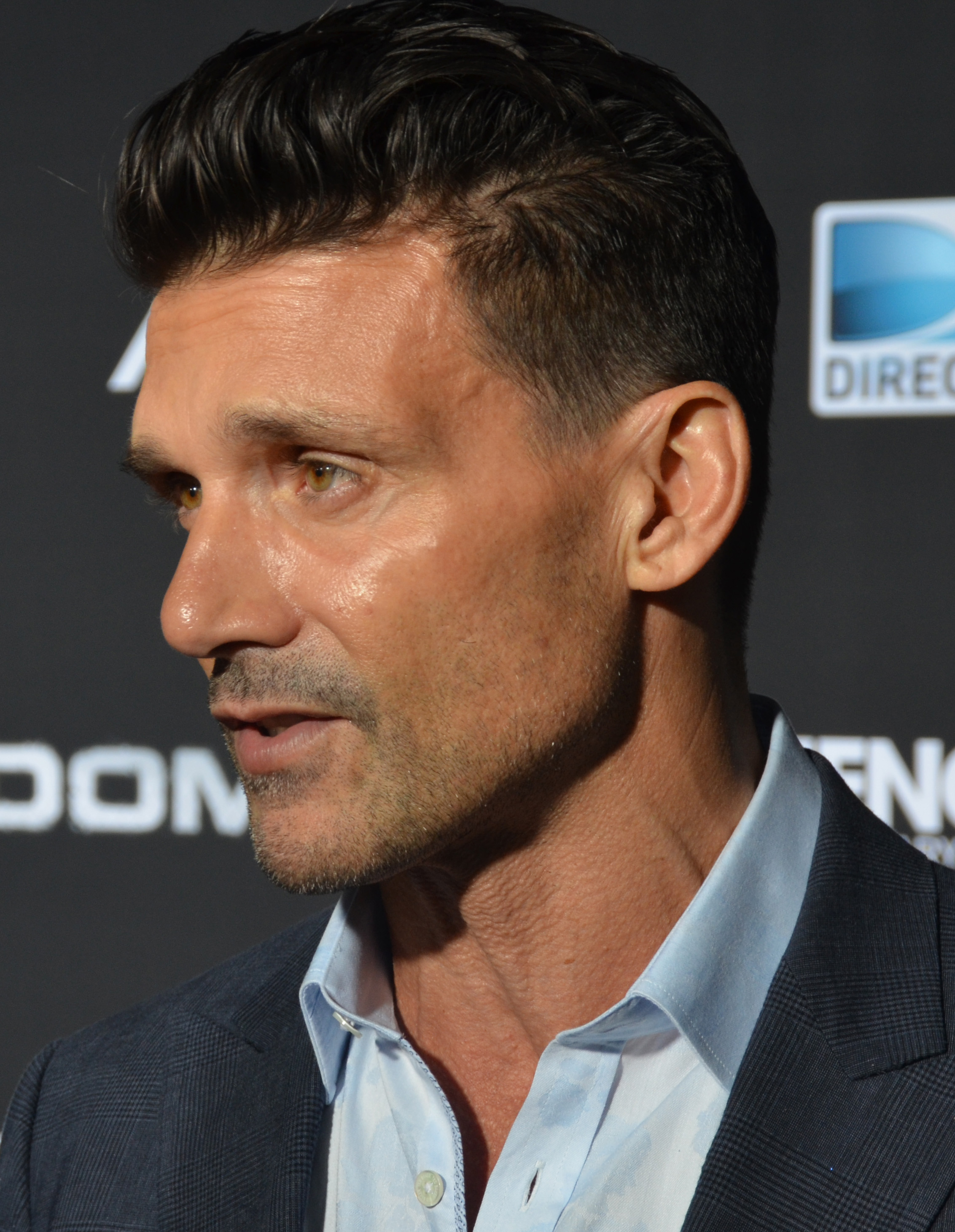
For more than two decades, the entertainment landscape has been profoundly shaped by the rise of superhero cinema. These blockbusters have not only dominated the global box office but have also placed an unprecedented spotlight on the physical transformations undertaken by their leading stars. From lean to muscle-bound in what often appears to be mere months, these dramatic shifts have consistently fueled public speculation and industry whispers about the true methods behind achieving such ‘superhuman’ physiques.
Yet, few figures in Hollywood have dared to address this sensitive topic with the forthrightness of actor Frank Grillo. At 60 years old, Grillo, known for his impactful roles across both the Marvel and DC film universes, recently offered a candid, no-holds-barred perspective that has sent ripples through the industry. His statements, delivered on Men’s Health’s “Strong Talk” vodcast, cut through the usual celebrity bravado, offering a rare glimpse into a conversation many prefer to keep behind closed doors.
Grillo’s remarks ignite a crucial discussion that extends beyond mere celebrity gossip, touching upon industry standards, ethical considerations, and the very definition of natural physical achievement in an era dominated by visually demanding roles. His willingness to speak openly serves as a vital catalyst for a more transparent dialogue about the pressures, practices, and perceptions surrounding body image and performance enhancement within Hollywood’s most physically demanding genre.

1. **Frank Grillo’s Central Allegation: Superhero Actors and PEDs**
Frank Grillo didn’t mince words when addressing the perennial question of how superhero actors achieve their dramatically enhanced physiques. His central allegation is strikingly blunt and direct: many, if not most, rely on performance-enhancing drugs (PEDs). Speaking in the latest episode of Men’s Health’s “Strong Talk” vodcast, Grillo declared, “None of those are natural bodies. Those guys don’t walk around looking one way for six months out of the year, and then all of a sudden, they have 35 pounds of muscle on them.”
This statement challenges the often-propagated narrative of solely natural, rigorous training and diet as the sole contributors to these transformations. Grillo suggests an open secret within the industry, emphasizing a collective awareness among insiders: “We all know what they’re doing. They might not want to say it, but they all do it. Everybody.”
When pressed by Men’s Health fitness director Ebenezer Samuel, C.S.C.S., on whether he had witnessed the use of such substances firsthand, Grillo’s response was unequivocally clear. He affirmed, “100 percent,” following a brief pause and a telling laugh. This direct confirmation from an actor deeply embedded in both the Marvel and DC film universes lends significant weight to his claims, transforming them from mere speculation into a direct industry testimony.
Grillo’s forthrightness marks a notable departure from the typical guarded responses actors provide when questioned about their physical preparations. His willingness to speak so openly signals a potential shift in the conversation, pushing for greater transparency in an area often shrouded in mystique and carefully crafted public images. It brings into sharp focus the reality of the extraordinary demands placed upon actors in this genre.

2. **Specific Substances Named: Anavar and Deca**
Further underscoring the specificity of his claims, Frank Grillo went beyond general accusations of performance enhancement, directly naming two particular substances: Anavar and Deca. He explained that actors achieve their incredible transformations “by taking Anavar, and Deca, and all the things that are now prescribable by doctors.”
Anavar (Oxandrolone) and Deca (Nandrolone Decanoate) are both synthetic anabolic-androgenic steroids. They are known for their ability to promote significant muscle growth, increase strength, and aid in faster recovery, often with less water retention compared to some other steroids, making them popular for achieving a lean, muscular physique. The mention of these specific drugs by Grillo highlights an intimate understanding of the practices he is describing.
The crucial distinction Grillo makes is that these substances are now “prescribable by doctors.” This detail introduces a layer of medical involvement and potential monitoring that might differentiate their use from illicit, unsupervised steroid abuse. It suggests a more controlled, albeit still performance-enhancing, approach under medical guidance.
This aspect of prescription and monitoring is presented by Grillo as a positive development, stating that it is “good because now it can at least be monitored by a medical professional.” This implies that while the use of such drugs is prevalent, there is an evolving framework, potentially making their application safer and more regulated within certain professional contexts. It adds complexity to the debate, moving beyond a simple good vs. bad dichotomy.

3. **The ‘Unnatural Bodies’ Argument and Rapid Transformations**
Central to Frank Grillo’s argument is the assertion that the superhero bodies showcased on screen are fundamentally “unnatural.” He challenges the notion that these extreme physiques are achievable through conventional means within the tight timelines often associated with film production. His observations directly contradict the public perception that these actors are simply genetically gifted or have an unparalleled work ethic.
Grillo vividly illustrates this point by stating, “Those guys don’t walk around looking one way for six months out of the year, and then all of a sudden, they have 35 pounds of muscle on them.” This highlights the rapid, dramatic changes in physique that often precede major film roles, changes that typically defy the natural limits of human physiology, especially for adult actors.
Experts in fitness and medicine often concur with Grillo’s implied skepticism. Gaining 35 pounds of pure muscle in a few months is an exceptionally challenging feat, even for highly dedicated individuals. Without pharmacological assistance, such rapid and significant gains are generally considered biologically improbable for most adult males, pushing the boundaries of what is naturally achievable.
This ‘unnatural bodies’ claim is significant because it speaks to the underlying pressure in Hollywood. Actors are expected to undergo stunning transformations in short periods, often for roles that demand an idealized, larger-than-life physical presence. Grillo’s remarks suggest that fulfilling these demands frequently necessitates methods beyond traditional training and nutrition, leading to physiques that are not sustainable or natural without external aid.

4. **Grillo’s Personal Experience: Testosterone Replacement Therapy (TRT)**
Adding another layer of authenticity to his discourse, Frank Grillo candidly shared his personal experience with performance-enhancing substances, specifically Testosterone Replacement Therapy (TRT). Unlike the speculative nature of his comments on other actors, Grillo openly discussed his own journey, revealing that he began taking testosterone six years ago.
His decision was not driven by the desire for a superhero physique but by medical necessity. Grillo explained that his doctor informed him his testosterone levels were low. This personal disclosure frames the conversation around a medically monitored, health-oriented use of hormones, distinct from recreational or competitive bodybuilding steroid use, yet still involving an exogenous hormone.
Since starting TRT, Grillo reports significant personal benefits. He states that the therapy “has helped him recover faster, sleep better, and improve his mood.” These are commonly cited advantages of TRT for individuals with clinically low testosterone, underscoring its role in enhancing overall well-being and physical function, particularly for an active individual like Grillo.
This openness about his own health and treatment choices serves multiple purposes. It humanizes the conversation around hormone therapy, demonstrating that not all use of such substances is for illicit gain. Moreover, it strengthens his credibility when discussing the prevalence of similar practices among his peers, as he is speaking from a position of direct experience with medically managed hormonal intervention.

5. **Grillo’s Justification: ‘Not Cheating Anything Except Aging’**
Frank Grillo meticulously articulates his rationale for his personal use of testosterone, drawing a clear distinction between his situation and what might be considered ‘cheating’ in a competitive context. He directly confronts potential criticism, stating, “People will say—because I take testosterone—‘you’re a cheater.’ I’m like, wait a minute.”
His justification is rooted in his age, profession, and lack of competitive engagement. “I’m 60, and I train every day. I’m an actor. I’m not the linebacker for the New York Giants. I’m not a competitive Olympic wrestler. I’m not playing for the New York Knicks,” Grillo explains. This argument highlights that his use of testosterone is for personal health maintenance and professional demands, not for gaining an unfair advantage in a sporting competition.
Grillo frames his TRT use as a means of combating the natural decline associated with aging, rather than an attempt to illegally boost performance. He asserts, “I’m not cheating at anything except aging.” This powerful statement reframes the narrative, presenting his choice as a way to maintain vitality and the physical capabilities required for his career as an action actor, a career that often demands peak physical condition even at an advanced age.
Extending this perspective, Grillo expresses a permissive view towards actors who use substances like Anavar to achieve superhero looks for roles. He states, “There’s nothing wrong with…you get the role in the superhero movie, and you want to look like a superhero, and you take some Anavar…god bless you.” This suggests a pragmatic, non-judgmental stance, acknowledging the immense pressure and desire for actors to embody the visual ideals of their characters, even if it requires pharmacological assistance.

6. **The Role of Medical Supervision for PEDs**
A significant point of emphasis in Frank Grillo’s discussion about steroid use in Hollywood is the critical role of medical supervision. He notes that substances like Anavar and Deca are “now prescribable by doctors,” framing this development as a positive step. This shift suggests a move towards a more controlled and potentially safer environment for actors seeking physical enhancement.
Grillo explicitly states that the ability to have these substances prescribed by doctors is “good because now it can at least be monitored by a medical professional.” This highlights the importance of oversight, implying that medical professionals can manage dosages, monitor side effects, and ensure the health and safety of the individuals undergoing such treatments. It differentiates this practice from the often dangerous, unregulated use of performance-enhancing drugs without medical guidance.
This aspect challenges the common perception of steroid use as universally reckless or illicit. By presenting it as a medically supervised process, Grillo opens a dialogue about harm reduction and responsible usage within the unique demands of the entertainment industry. It suggests that if actors are going to use these substances, having them monitored by doctors is the most prudent approach.
The involvement of medical professionals adds a layer of legitimacy and caution to a practice often viewed with suspicion. It implies a recognition that actors are under immense pressure to transform their bodies, and if this involves pharmacological assistance, ensuring medical guidance is paramount. This perspective contributes to a more nuanced understanding of performance enhancement in Hollywood, moving beyond simple condemnation to acknowledge the practical realities and the evolving medical landscape surrounding these substances.

7. **Expert Warnings: Normalizing Steroids for Young Fans**
Frank Grillo’s candor, while laudable for sparking dialogue, has also prompted serious warnings from medical professionals. The primary concern revolves around the potential for such high-profile disclosures to inadvertently normalize performance-enhancing drugs (PEDs), especially among young, impressionable fans who are acutely susceptible to body image pressures.
Dr. Jason Nagata, a pediatrician specializing in eating disorders at the UCSF Benioff Children’s Hospitals, clearly articulated this risk. He explained, “When celebrities and influencers openly discuss steroid use, it can normalize these substances for kids and teens who are already under pressure to look muscular.” This normalization can subtly shift the public perception of PEDs, making them appear as acceptable tools rather than medically potent substances with inherent risks.
Furthermore, Dr. Nagata cautioned that the “mix of social media and Hollywood steroid culture can push boys from normal gym goals into unhealthy obsession.” For some, he warned, this environment can lead to “risky behaviors, unhealthy eating, or an obsession with getting bigger.” The glamour of celebrity transformations, if not paired with transparency about their true methods, can establish a dangerous precedent for young people striving to emulate their heroes.
This ethical dilemma underscores how celebrity influence extends far beyond entertainment, impacting public health and the psychological well-being of millions. It highlights the critical need for more responsible narratives surrounding physical ideals in popular culture.

8. **The Creation of Unrealistic Body Image Expectations**
A significant consequence of the entertainment industry’s lack of transparency regarding physical enhancement is the propagation of unrealistic body image expectations. When actors achieve extreme muscularity through assisted means but present it as solely the result of natural training and diet, it creates an unachievable standard for the wider public.
Andrew Heffernan, a veteran trainer and C.S.C.S., meticulously addressed this issue. He observed, “When celebrities claim to be natural when they’re not, they contribute to a false sense of what’s possible without PEDs.” This deliberate or unintentional misrepresentation leads audiences to believe that rapid, dramatic physique changes are attainable through conventional methods, which is rarely the biological reality.
Grillo’s own astute observation—”Those guys don’t walk around looking one way for six months out of the year, and then all of a sudden, they have 35 pounds of muscle on them”—directly confronts this misleading narrative. Heffernan reinforces this biological truth, stating, “in my experience the only people who can gain 35 pounds of muscle in a few months without drugs are very athletic teenagers. Otherwise, it just doesn’t happen.”
This profound disconnect between the on-screen ideal and the practical limits of human physiology can result in widespread body dissatisfaction and self-doubt. It pressures individuals to pursue an ‘ideal’ that is often chemically manufactured, fostering an unhealthy pursuit of the unattainable.
Read more about: Erika Eleniak’s Enduring Journey: From ‘Baywatch’ Icon to a Life Defined by Resilience and Reinvention

9. **Industry Pressures Driving Physical Transformations**
The relentless pursuit of the ‘superhero’ physique is not merely a personal choice for actors but a deeply embedded aspect of Hollywood’s commercial and aesthetic demands. The “boom in superhero films over the last two-plus decades” has irrevocably raised audience expectations, placing an “unprecedented spotlight on the physical transformations” of leading stars.
Actors are now routinely expected to undergo stunning, almost miraculous, physical changes, frequently needing to gain “tens of pounds of muscle in a short period of time.” These transformations are dictated by the “tight timelines often associated with film production,” allowing little to no room for gradual, natural muscle development. This intense schedule often necessitates faster, more aggressive methods to meet visual requirements.
Frank Grillo’s pragmatic view on the matter vividly illustrates these systemic pressures. His statement, “There’s nothing wrong with…you get the role in the superhero movie, and you want to look like a superhero, and you take some Anavar…god bless you,” while seemingly permissive, highlights the immense professional requirements. He acknowledges that, for many, pharmacological assistance becomes a necessary, albeit medically managed, tool to fulfill the visual demands of a highly competitive and lucrative genre.
This creates a self-reinforcing cycle: enhanced physiques drive box office success, which then escalates pressure on future actors to achieve even more extreme body types. Fulfilling these aesthetic demands becomes a crucial component of securing high-profile roles, indicating that individual choice is often secondary to professional imperative.
Read more about: Top 6 Famous People That Ruined Their Career With One Photo

10. **The Broader Debate: Transparency and Honesty in Hollywood**
At the core of the discussion ignited by Frank Grillo’s revelations is a fundamental demand for greater transparency and honesty within Hollywood regarding the physical transformations of its stars. Grillo’s straightforward plea, “But let’s be honest about it. That’s all,” serves as a potent challenge to the carefully crafted illusions that often surround the physiques of movie stars. This call for candor resonates strongly with a public increasingly desiring authentic narratives.
Andrew Heffernan, the veteran trainer, echoed this sentiment, highlighting the problematic “lack of transparency from actors regarding how they’re bulking up and getting jacked.” He argues that this secrecy is far from harmless; it actively “contribute[s] to a false sense of what’s possible without PEDs.” The absence of honest disclosure leaves audiences to fill in the gaps with assumptions, often leading to misinformation and unrealistic personal goals.
This lack of transparency extends beyond individual choices to the broader industry, prompting questions about the ethical responsibilities of studios, publicists, and media outlets. When the full story behind a dramatic transformation isn’t disclosed, it perpetuates a myth that can be damaging, particularly to those who attempt to replicate such results through potentially unsafe means.
Grillo’s remarks have definitively “added fuel to a growing conversation about body image, performance enhancement, and honesty in Hollywood.” This evolving dialogue compels the industry to confront its own practices and consider the ethical implications of presenting unattainable ideals without full disclosure.

11. **Ethical Considerations of Endorsement and Influence**
The immense influence wielded by Hollywood figures carries a substantial ethical responsibility, particularly when their physical transformations—often facilitated by performance-enhancing drugs—are presented without complete transparency. This practice can be seen as an implicit endorsement of an aesthetic that, if pursued without medical guidance or an understanding of its true origins, poses significant health risks to the general public.
Dr. Jason Nagata’s warnings are critically relevant here, as he stresses how celebrity discussions about steroid use can “normalize these substances for kids and teens.” This normalization is an ethical hazard, effectively presenting a dangerous path for impressionable individuals who may not fully grasp the risks, side effects, or legal ramifications of PEDs. The compelling power of a celebrity’s image means their perceived methods become aspirational, irrespective of the underlying realities.
Moreover, the carefully constructed narratives that frequently accompany these transformations—often emphasizing only diet and intense workouts—constitute an ethical dilemma. They mislead the public into believing that such extreme changes are universally achievable naturally, thereby devaluing the genuine efforts of natural athletes and setting unrealistic benchmarks. This fosters body dissatisfaction and encourages a willingness to seek potentially harmful shortcuts.
Frank Grillo’s seemingly permissive stance, saying “god bless you” to actors using Anavar for roles, while framed by his personal context, nevertheless contributes to this broader ethical discussion about responsible messaging. The core ethical imperative stems from the fact that the general public often doesn’t draw such fine distinctions when evaluating their own body image goals against celebrity standards.
Read more about: Unmasking the Pedestal: 15 Revered Historical Figures Whose Dark Sides Will Shock You

12. **The Unanswered Questions and Future of the ‘Superhero’ Physique**
Frank Grillo’s candid intervention has served not as a conclusion, but as a potent catalyst, broadening and deepening a critical conversation that leaves many profound questions about the future of the ‘superhero’ physique in Hollywood. The “debate over steroid use in Hollywood is unlikely to end anytime soon,” primarily because the foundational pressures, visual demands, and commercial incentives driving these transformations remain powerful forces.
At the forefront of these unresolved issues are the questions explicitly articulated within the ongoing discourse: “Should actors be more transparent about the methods behind their transformations? And what responsibility do they have when their physiques influence millions of fans?” These are complex inquiries, balancing individual privacy against a public figure’s significant societal influence, especially within an industry built on elaborate illusions.
Grillo’s willingness to speak openly could, however, represent a pivotal shift. His ‘frank’ approach might inspire more industry insiders to engage in similarly honest dialogues about the realities of physical enhancement. This could, in turn, pressure studios and production companies to either recalibrate their aesthetic demands or, at the very least, support a more transparent narrative surrounding their stars’ on-screen transformations.
The future may well lead to increased disclosure, perhaps through explicit acknowledgments or more nuanced discussions in media, recognizing the role of medical science alongside traditional training. Such an evolution could foster a more realistic and responsible portrayal of physical ideals, guiding audiences away from potentially harmful illusions towards a more informed understanding.
Ultimately, the ‘superhero’ physique will continue to evolve, but its trajectory will be significantly shaped by the industry’s capacity for self-reflection and its commitment to greater honesty. Grillo’s remarks serve as a powerful reminder that authenticity, even within the realm of fantasy, is increasingly a public expectation.
The candid revelations from seasoned industry figures like Frank Grillo are more than just behind-the-scenes gossip; they are a vital catalyst for a much-needed reckoning within Hollywood. As the industry continues to churn out visually spectacular narratives, the dialogue Grillo has initiated challenges us all to look beyond the dazzling surface, to understand the intricate pressures, the personal choices, and the far-reaching societal impacts that shape the bodies of our on-screen heroes. It’s a call for authenticity in an industry often built on illusion, urging a move towards a more responsible and transparent portrayal of the human, or indeed, the superhuman, form.



